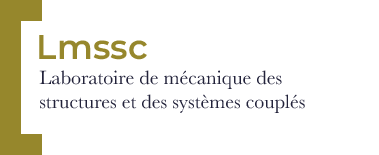Modal analysis of metallic structures filled with elastomer and inverse identification of material parameters
Résumé
Hollow designs for mechanical structures lead to weight reduction but generally induce a highly resonant behavior. Vibration reduction of hollow structures can be achieved by casting a viscoelastic material into their cavities. The damping performance of these filling materials is assessed by studying modal parameters, including eigenfrequencies, modal damping, and mode shapes. To avoid local effects of material testing or to perform material health monitoring, an inverse identification method for viscoelastic material properties is proposed. This method involves identifying four parameters of a fractional-derivative Zener model of the complex, frequency-dependent shear modulus of viscoelastic material. The reduced basis method is used to efficiently compute the Frequency Response Functions (FRF) from a finite element model of a structure filled with viscoelastic material. Modal parameters are extracted from the model by applying Experimental Modal Analysis techniques (EMA) to the numerical FRF. Additionally, vibration tests are conducted on a hollow beam with a rectangular cross-section under different temperature conditions, between 10 and 30 °C. Modal parameters are extracted from the experimental FRF using EMA. Two inverse identification approaches are presented based on a criterion involving modal parameters. The first approach uses modal parameters measured at a single temperature, while the second approach utilizes those measured across all temperatures. By including temperature measurements and applying the time-temperature superposition principle, the shear modulus varies over a wider frequency range. This makes the identified material parameters more reliable compared to those obtained from inverse identification using single-temperature measurements.

